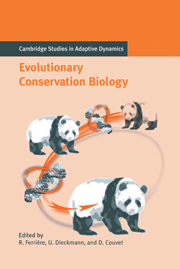Book contents
- Frontmatter
- Contents
- Contributing Authors
- Acknowledgments
- Notational Standards
- 1 Introduction
- Part A Theory of Extinction
- Part B The Pace of Adaptive Responses to Environmental Change
- Part C Genetic and Ecological Bases of Adaptive Responses
- Part D Spatial Structure
- Part E Community Structure
- References
- Index
- The International Institute for Applied Systems Analysis
Part E - Community Structure
Published online by Cambridge University Press: 15 August 2009
- Frontmatter
- Contents
- Contributing Authors
- Acknowledgments
- Notational Standards
- 1 Introduction
- Part A Theory of Extinction
- Part B The Pace of Adaptive Responses to Environmental Change
- Part C Genetic and Ecological Bases of Adaptive Responses
- Part D Spatial Structure
- Part E Community Structure
- References
- Index
- The International Institute for Applied Systems Analysis
Summary
Introduction to Part E
“No man is an island”, and no species of conservation interest exists in isolation from others. Ecosystems define the ecological theater, not only for any evolutionary play, but also for unfolding tales of population decline or rescue. This book therefore ends with a part on the community-level aspects of evolutionary conservation biology. In this way, we establish several additional perspectives to our general question on the ecological, demographic, and genetic conditions that enable or hinder populations to overcome extinction threats through adaptation.
On the ecological side, many density-dependent and frequency-dependent selection pressures emerge from interspecific interactions. It is the dependence of focal populations on the abundance of their resources, preys, predators, mutualistic partners, and competitors that creates complex webs of fitness effects and thus determines the strength and direction of natural selection. An interesting level on which to express such dependences is the flow of nutrients through ecological systems. Measures of nutrient cycling not only serve as indicators of ecosystem functioning, but also provide a convenient platform for resolving the interaction between organisms and their environment and for characterizing the implications of anthropogenic change.
On the demographic side, density regulation in communities is often nonlinear and can result in the coexistence of multiple demographic attractors. Anthropogenic change can, temporarily or permanently, tilt the established balance between regulating forces, and so lead to shifts of or even switches between demographic equilibria.
- Type
- Chapter
- Information
- Evolutionary Conservation Biology , pp. 301 - 304Publisher: Cambridge University PressPrint publication year: 2004



